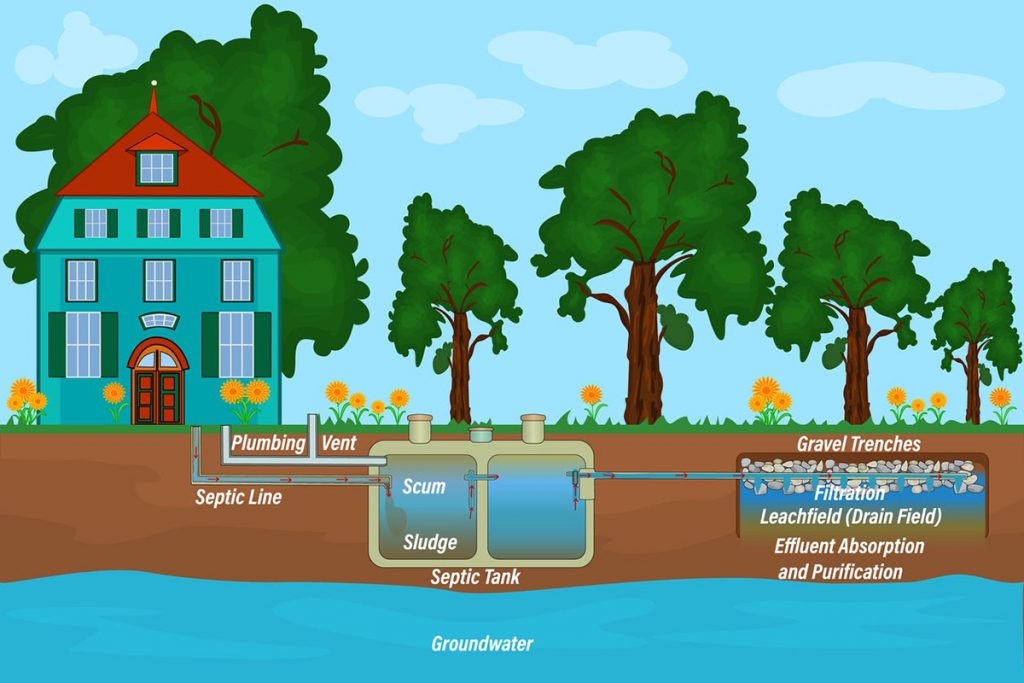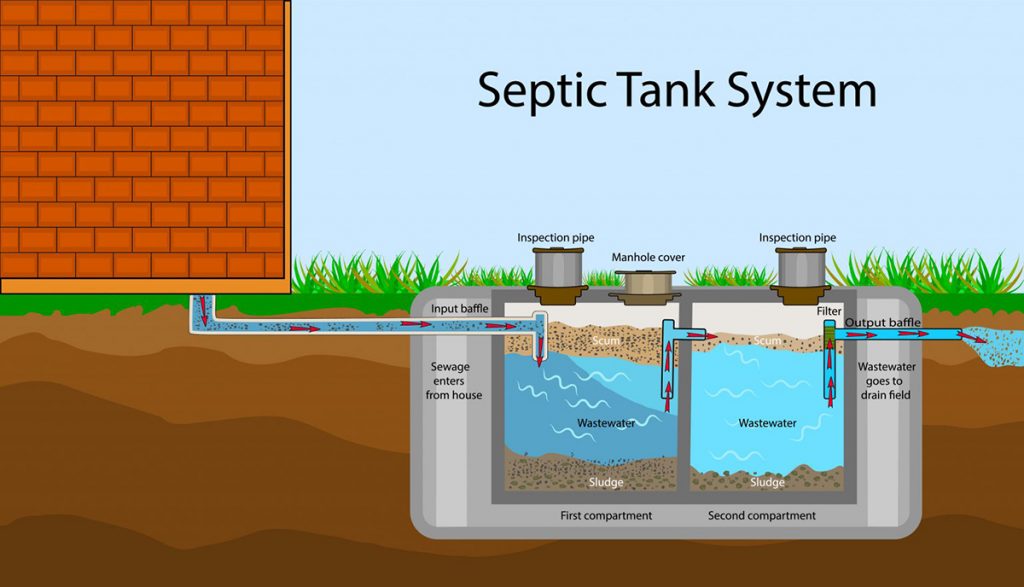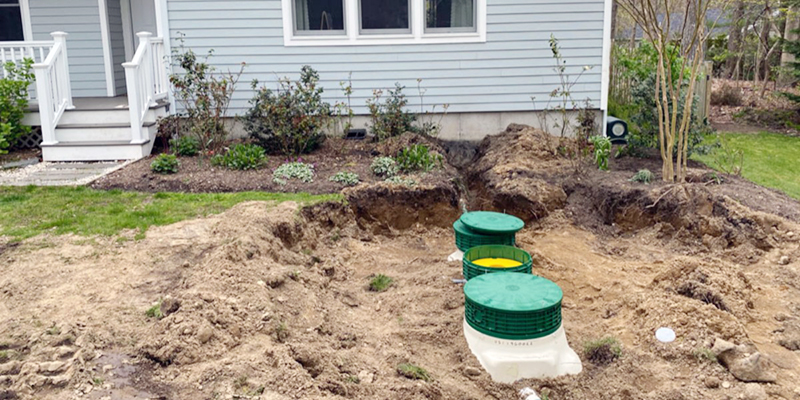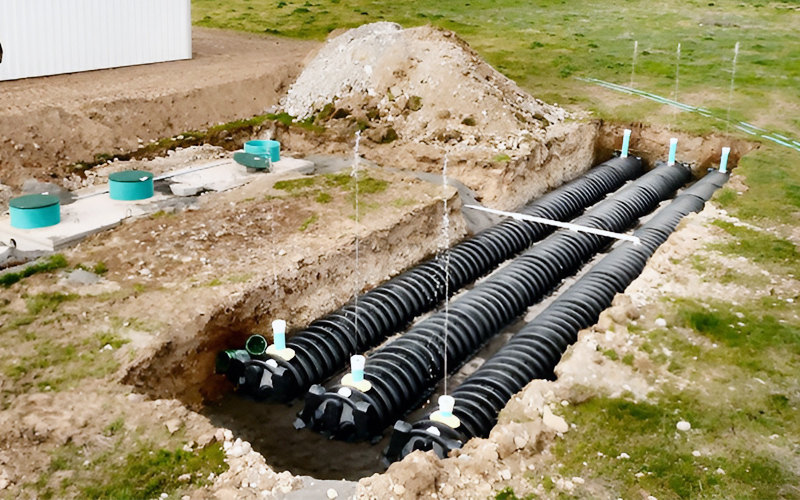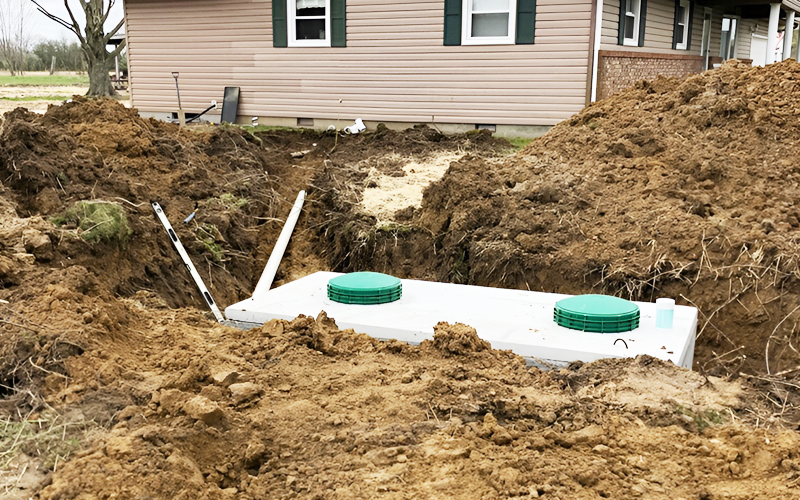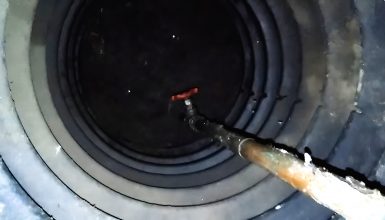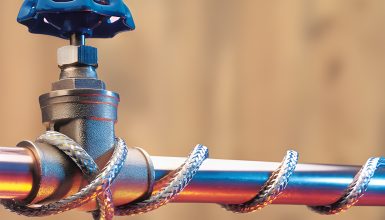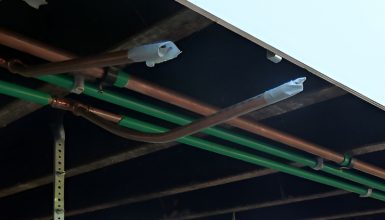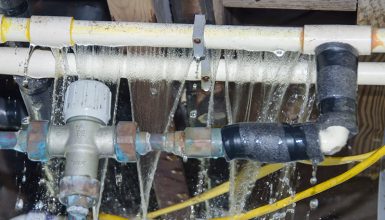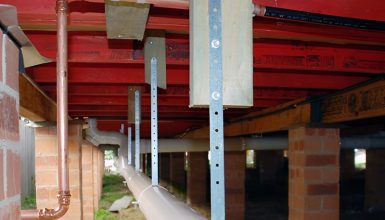Like traditional homes, mobile homes need efficient septic systems to manage waste effectively and keep your surroundings clean and healthy.
You wouldn’t want unpleasant odors or, worse, sewage backups ruining your idyllic mobile home experience, right? That’s why it’s essential to understand the importance of septic systems for mobile homes. It ensures you have the correct setup to avoid any nasty surprises.
In this guide, we’ll take you through the nitty-gritty of septic systems. Helping you choose, install, and maintain the best one for your mobile home.
Basic Septic System Components
Alright, let’s start with the basics. A septic system has three main parts that work together to manage waste from your mobile home.
- Septic tank
First up is the septic tank. This underground tank is made of concrete, fiberglass, or plastic, where all the magic happens. When wastewater from your home flows into the tank, solids settle at the bottom, forming a sludge layer. Lighter materials, like fats and oils, float to the top, creating a scum layer. Between these two layers is a clear liquid called effluent, which will eventually leave the tank.
- Drain field
Next, we have the drain field, also known as the leach field or soil absorption field. Picture a series of underground pipes with small holes surrounded by gravel or sand. The effluent from the septic tank flows into these pipes, distributing it evenly throughout the drain field. It’s here that the wastewater gets treated by the soil’s natural processes.
- Soil absorption system
Finally, there’s the soil absorption system. It is Mother Nature’s very own filtration system. As the effluent percolates through the soil, harmful bacteria and viruses are removed. It makes the water safe to re-enter the environment. Pretty cool, right?
How Septic Systems Work
Now that we know the key components of a septic system let’s talk about how they all work together. Trust me; it’s not as complicated as it sounds! Just follow along as we walk you through the process.
Imagine you’ve just flushed the toilet or used the sink in your mobile home. The wastewater from these activities goes through your home’s plumbing and heads straight to the septic tank. Once it’s in the tank, the waste starts to separate.
Remember the sludge and scum layers we mentioned earlier? It is where they come into play. The heavier solids sink to the bottom, and the lighter materials float to the top. The clear liquid (effluent) in the middle is the show’s star, as it’s the part that gets treated and released back into the environment.
But before that happens, the effluent must pass through the drain field. It flows from the septic tank into the perforated pipes we discussed, which are buried in the soil and surrounded by gravel or sand. This setup helps to distribute the effluent across the drain field area evenly.
Now, it’s time for the soil to work its magic. As the effluent percolates through the soil layers in the absorption system, harmful bacteria and viruses are removed. The soil acts like a natural filter, purifying the water so it’s safe to re-enter the groundwater system.
Types of Mobile Home Septic Systems
Source: Awsli
Now that you know how septic systems work, let’s explore the available types. After all, not all mobile homes are the same, and neither are their septic system needs! So, let’s check out the most common options and see which one might best fit your mobile home.
1. Conventional Systems
These are the most common type of septic systems you’ll find. They typically include a septic tank and drain field, as described earlier. They’re a solid choice for most mobile homes, especially if you have enough space and the right soil conditions on your property.
2. Aerobic Treatment Units (ATUs)
An ATU might be your best bet if your mobile home site has limited space or less-than-ideal soil. These systems use oxygen to break down waste more efficiently than conventional systems. They have a separate tank where the air is pumped in, encouraging the growth of helpful bacteria that break down waste faster. The treated effluent is then released into a smaller drain field or sometimes used for irrigation.
3. Above-Ground Septic Systems
Have you got a high water table or shallow bedrock? No problem! Above-Ground or mound systems are designed for just that. They consist of a septic tank and a unique drain field built on a raised mound of sand and gravel. This elevated setup helps to treat the effluent before it reaches the water table.
4. Sand Filter Systems
These are similar to conventional systems but have an added twist – a sand filter between the septic tank and drain field. The effluent passes through the sand filter, which provides additional treatment by removing more contaminants before the wastewater reaches the drain field. It can be beneficial if your property has poor soil conditions.
5. Evapotranspiration Systems (ET)
If you live in an arid region with low rainfall, an ET system might be just the ticket. These systems use the power of the sun and wind to evaporate wastewater. They are leaving behind only a small amount of solid waste that needs to be periodically removed. They’re an excellent option for water conservation, but they’re not suitable for all climates.
Choosing the Right Septic System for Your Mobile Home
Source: sierracounty.ca.gov
Okay, so we’ve covered the basics of septic systems and the available types. Now comes the big question: how do you choose the right one for your mobile home? No worries, we’ve got you covered! Let’s review some key factors to consider when making this critical decision.
- Assessing your needs
Start by taking a good look at your mobile home and its surroundings. How big is your home, and how many people live there? It will help you determine the capacity your septic system will need to handle. Also, check out the available space on your property. And any local regulations or requirements that might affect your choice.
- Comparing septic system options
Now that you know your needs, it’s time to weigh the pros and cons of each septic system type. Remember the five options we discussed earlier? Go back and review those, keeping your specific needs in mind. Consider factors like installation costs, maintenance requirements, and environmental impact to narrow your choices.
- Seeking professional advice
It’s always a good idea to consult with an expert before making a final decision. After all, they have the experience and knowledge to help you choose the best septic system for your mobile home. Contact a local septic system installer or engineer to discuss your options and get their recommendations.
- Local regulations and permits
Don’t forget to check your local regulations and permit requirements before you decide on a septic system. Some areas may have restrictions on certain types of systems. Or they might require specific permits and inspections. Ensure you know these regulations to choose a septic system that complies with them.
Mobile Home Septic Tank Installation and Setup
So, you’ve chosen the perfect septic system for your mobile home. Congrats! Now it’s time to roll up your sleeves and prepare for installation and setup.
- Finding a reputable installer
The first and most crucial step is to find a trustworthy, experienced installer to handle your septic system installation. Do your research, read reviews, and ask for recommendations from friends or neighbors. Remember, a skilled installer can make all the difference in getting your system up and running smoothly.
- Pre-installation preparation
Before the actual installation begins, there’s some groundwork to be done. It includes obtaining necessary permits from local authorities and selecting the best site for your septic system. Your installer can help you with these tasks, ensuring everything is in order before the big day arrives.
Installation Process Overview
So we’ve discussed finding a reliable installer and getting everything prepped for installation. Now, let’s dive into the exciting installation process itself!
1. Excavation
The first step is to dig the hole for your septic tank and the trenches for the drain field. Your installer will use heavy equipment to remove the soil and make room for the tank and piping. They’ll carefully follow any guidelines for depth and distance from your mobile home to ensure everything is up to code.
2. Tank Placement
Once the hole is ready, it’s time to place the septic tank. Your installer will lower the tank into the hole, ensuring it’s level and secure. They’ll then backfill the tank with soil or gravel to keep it in place.
3. Pipe connections
Your installer will now connect the pipes from your mobile home to the septic tank. It is where all the wastewater will flow from your home into the tank for treatment. They’ll also connect the pipes from the tank to the drain field so that the treated effluent can be dispersed into the soil.
4. Drain field setup
The installer will lay out the perforated pipes in the drain field trenches at this stage. They’ll ensure the lines are level and evenly spaced to distribute effluent properly. Then, they’ll cover the pipes with gravel or sand to help with filtration and support.
5. Final backfill and clean up
Once all the components are in place and connected, the installer will backfill the remaining trenches with soil. They’ll also grade the area to ensure proper drainage and prevent standing water. Lastly, they’ll clean up the site, removing debris or excess materials.
Maintaining Your Septic System
So now that you’ve got your new septic system installed and ready to go, you might wonder how to keep it running smoothly for years. Fear not; we’ve covered you with some essential maintenance tips to help you avoid surprises.
- Regular inspections
Just like with any home system, it’s essential to have your septic system inspected regularly. Schedule a check-up with a professional every one to three years, depending on your system’s size and usage. They’ll ensure everything works and catch potential issues before they become big problems.
- Pumping the tank
Over time, solids will build up in your septic tank and must be pumped out. Most experts recommend pumping your tank every three to five years. But this can vary depending on your household size and water usage. Your septic professional can help you determine the best schedule for your situation.
- Mind what goes down the drain.
Be mindful of what you’re sending down your drains and toilets. Avoid flushing non-biodegradable items like wipes, diapers, or feminine hygiene products, as they can clog your system. Also, limit harsh chemicals and detergents. They can disrupt the natural bacteria in your septic tank that help break down waste.
- Conserve water
Using water efficiently can help prevent your septic system from becoming overloaded. Simple steps like fixing leaks, using low-flow fixtures, and spreading out laundry loads throughout the week can make a big difference in keeping your system running smoothly.
- Care for your drain field.
Show your drain field some love by keeping it clear of heavy vehicles or construction equipment that could damage the pipes. Also, avoid planting trees or shrubs near the drain field, as their roots can interfere with the lines. Lastly, ensure the area is graded properly to prevent standing water or flooding.
FAQs
No, mobile homes typically do not come with septic tanks. You’ll need to purchase and install a separate septic system for your mobile home based on local regulations and specific needs.
The size of the septic tank needed for your mobile home depends on the number of bedrooms, occupants, and water usage. Generally, a 1,000-gallon tank is suitable for a two- or three-bedroom mobile home with up to four occupants. At the same time, a 1,250-gallon tank is for a four-bedroom with five or more occupants.
Yes, there are specific requirements for mobile home septic tanks, which can vary depending on your location. Local health departments or environmental agencies often set septic system design, installation, and maintenance guidelines. It’s essential to consult with a professional installer familiar with your area’s regulations.
The cost of a septic tank for a mobile home varies based on the type and size of the tank, as well as your location. On average, a concrete, fiberglass, or plastic septic tank can range from $600 to $2,000. Remember that this cost is for the tank alone and does not include installation or other system components.
The cost to install a septic system for a mobile home depends on the type of system, location, and site conditions. On average, you can expect to pay between $3,000 and $15,000 for a complete septic system installation, including the tank, drain field, and labor. The cost may be higher for more complex systems or challenging site conditions.
The cost to empty a septic tank for a mobile home ranges from $200 to $500, depending on the size of the tank and your location.
Conclusion
We’ve covered everything from the different types of septic systems to the installation process and essential maintenance tips. We know it might seem like a lot to take in. Still, with the proper knowledge and a reliable installer, you’ll be well on your way to enjoying the benefits of a well-functioning septic system. Happy mobile living!

